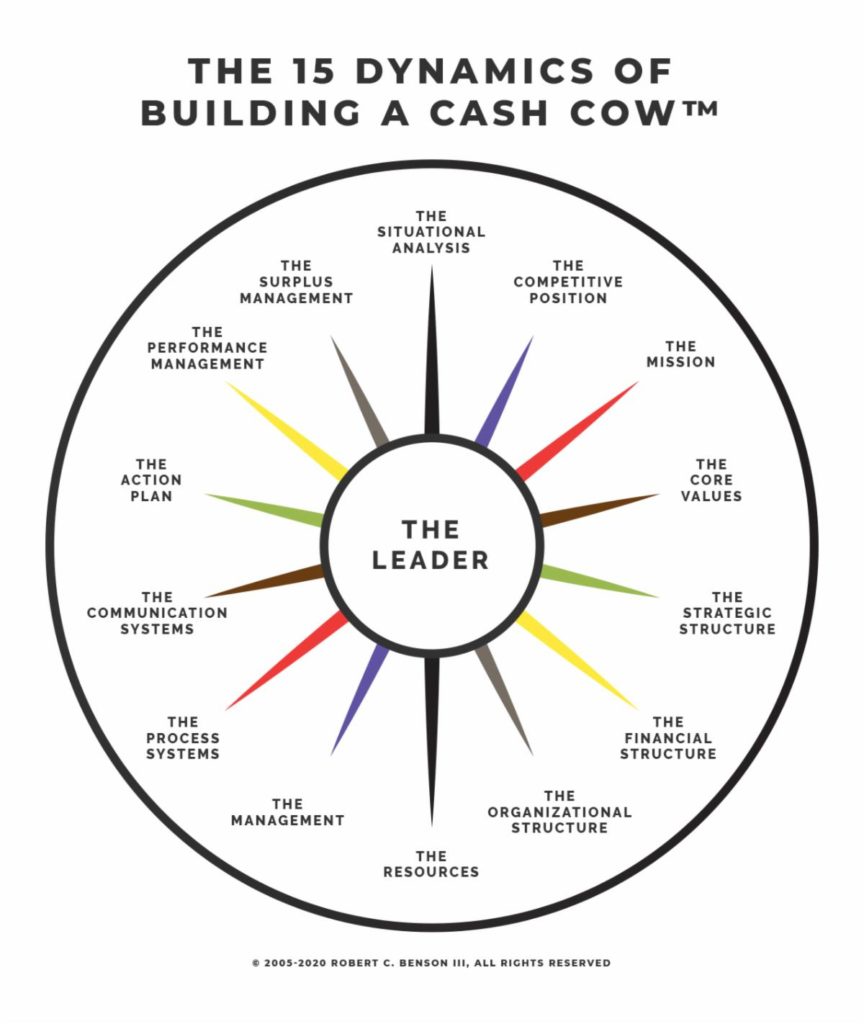The 15 Dynamics of Building a Cash Cow™ PART 4
THE MISSION STATEMENT
I am writing a series of articles on The 15 Dynamics of Building a Cash Cow™. Most of the articles, including this one, are applicable to both profit and non-profit companies. In this article, we suggest using the planning and insights you gained from Parts 2 and 3 to develop or update your mission statement. THE MISSION STATEMENT IS YOUR NORTH STAR!
Recap
IN THE INTRODUCTION, I presented The Driving Principle that “all data is not equal.” Ralph Waldo Emerson noted that “The value of a principle is the number of things it will explain.” Why? Because it is transferable to many applications and realms of our life and business. Then I discussed an insight that is even more powerful: “The value of a Driving Principle is the number of things it will do for your company.” Applying them will transform the company.
IN PART 1, THE LEADERSHIP, I created the awareness of The Driving Principle: “The leader’s belief system determines the effectiveness of the leader and the company.” Faulty beliefs, of which there are many in the business world, like “formal business planning is a waste of time,” significantly limit your profits and growth.
IN PART 2, THE SITUATIONAL ANALYSIS, it was noted that a sound business plan begins with a situational analysis. The Driving Principle: “To know where you are going, you must first know where you are.” Therefore, we provided the readers with methodologies to perform a competitor analysis, a SWOT analysis, and an external forces analysis.
IN PART 3a & 4a, THE COMPETITIVE POSITION, you learned that there are three Core Competitive Strategies and only three! Then you learned there are 16 Grand Strategies. The Driving Principle of each of these is “Pick one and give total commitment to it!” Then we demonstrated how to use them to design a competitive position to take you to the next level.

What the leader believes to be reality is reflected and integrated into the company through his/her behavior and decisions. I know it is intimidating, but Consider how the beliefs of a U. S. President affect our country, and a governor has on you and the state you live in. Think about the impact leaders of the companies you have worked for had or have on the companies. And the impact your parents had/have on you and your family? My objective is to empower you with sound Driving Principles.
Driving Principles have the power to drive the culture, growth, profits, cash flow, and overall success of your company to the next level and beyond to the top 25% of your industry. Even if you are profitable and growing, if your company’s financial performance is not in the top 25%, it is underperforming. On average, the top 25% of companies make about twice as much profit as the middle 50% and about three times as much profit as the average company. I hope you enjoy putting these Driving Principles to work in your company.
Case Study
Remember the small general contractor (SGC), a builder of commercial buildings, we discussed in PART 2? Although they had been in business for years, they only had about $20 million in revenue. However, they were realizing 15% in net income before taxes. I was amazed! About 30% of the companies I worked with during my consulting career were in the construction industry. Never had I seen one consistently making that large of net profit. However, they were stuck at that level! I worked together with them to build a strategic business plan to reach their goal of $100M in revenue. Three years later they achieved their goal. What made the difference?
One Autumn day, their president (Doug) called American Business Advisors and the call was transferred to me. Doug wanted to know if we helped facilitate business planning retreats. It was for their annual meeting to make a business plan for the next year. I explained that we don’t usually do that kind of planning because you can’t really develop a good plan in one weekend. He asked if I would make an exception because his leadership team, comprised of four owners, of which he was the majority owner, always spend all of their time auguring and never get anything accomplished. After some additional discussion, I agreed to accommodate his request.
“Our view of reality is like a map with which to negotiate the terrain of life. If the map is true and accurate, we will generally know where we are, and if we have decided where we want to go, we will generally know how to get there.” M. Scott Peck, M.D., The Road Less Traveled
I asked Doug if they had a mission statement. He said yes and they had scheduled five minutes to talk about it. I asked him to send me a copy. What they called their mission statement was really a list of four objectives. I called Doug and explained that what they had was not a mission statement and that to get the company to the next level we would need more time on the agenda for it. “How much,” he asked? “A half-day” I answered. He said that was impossible and called me back later and gave me one hour. He also agreed to give me two hours to do a SWAT analysis. In the meeting, I did the SWAT first. Then we went through the Mission Statement development process below. We ended up spending the entire weekend talking about what the mission statement should be and never did get a consensus. “How do we get past this?” they asked. We set up a schedule to develop a formal strategic business plan and I took them through the entire process of PARTS 2-6 of the 15 Dynamics of Building a Cash Cow™. Nine months after I got their call, they came to a consensus on a mission statement and formal business plan. Three years later they reached their goal of $100 million in revenue.
“A visionary company is one which is seen growing in a consistent pattern by being goal-oriented driven by a vision and a mission” Henrietta Newton Martin, Author Industrial Relations Today
Did you know there are key strategic reasons why God’s Son, Jesus Christ, came to earth? They are in the Bible to show and enable His followers how to accomplish His Mission. Yes, God is a planner, and Jesus Christ, the leader of God’s Kingdom, is the implementer. His mission statement is found in Matthew 28:18-20. The key strategies are spread throughout the 15 Dynamics articles. Check it out for yourself, see if you can find them throughout these articles.
The Vision
There are three components to an excellent Mission Statement, the Vision, a Mission, and a Purpose. The Mission Statement is your North Star. It communicates to the entire organization what your passion is, the direction of the company and why!! These are imperative in giving the organization clarity, direction, and motivation to participate.
The Vision is the leader’s imagined future of what the company can and wants to be and how the world can benefit. It is the dream! It can be inspirational and very powerful (if it is in writing and communicated throughout the organization as it grows). The Driving Principle: Without a vision the people perish, King Solomon. Put your passion into words.
VISION EXAMPLE
Our passion is engineering building systems that provide safe, exceptional patient care environments for healthcare facilities.
“Without a Goal, You Can’t Score.” Plato
The Mission
Think of your mission as the “super goal” for the company. What you want to be the best at in your market. Integrate your strengths, core competency, and Core Competitive Strategy into the mission. The Driving Principle: “Without a goal, you can’t score.”
MISSION EXAMPLE
Our goal is to increase our client base and revenue by expanding into selected new markets throughout the western half of the U.S.
The Purpose
The purpose is the “why.” It reaches into the heart and answers the question “Why should I be passionate about committing to the vision and mission?” The Driving Principle: “People do things for their reasons, not yours.” Do you know why? Because God made us that way. Read Psalm 139 in the Bible. As pointed out above, God has a plan for you. A good one!
“‘For I know the plans I have for you,’ declares the Lord, ‘plans to prosper you and not to harm you, plans to give you hope and a future. Then you will call on me and come and pray to me, and I will listen to you. You will seek me and find me when you seek me with all your heart.'” Jeremiah 29:11-13 NIV
PURPOSE EXAMPLE
Our purpose is to make a difference by enhancing our client and patient healthcare through our unique engineering approach and skills.
YOUR VISION AND THE DRIVING PRINCIPLES
I encourage you to follow along with me as we examine the Driving Principles and beliefs fueling The 15 Dynamics of Building a Cash Cow™. When we are done you will have a valuable blueprint to build your business and accomplish your vision and goals.
Next, in PART 5, we will examine how to develop The Core Values so they are sustained throughout the company over time and how to help employees focus on making decisions with them.
The Lord be with you and keep you safe!

If you have feedback or questions for Bob, email him at bob@CCBAlliance.org. For more information on The Colorado Christian Business Alliance go to CCBAlliance.org.
Robert C. Benson III (Bob) is the co-founder and past President/CEO of American Business Advisors, Inc., a Business strategic, finance, and management advisory firm specializing exclusively in the unique opportunities and issues faced by small and mid-sized companies. He successfully founded or co-founded seven businesses, including being a co-founder and former President of SecurCare Self Storage, Inc., now National Storage Affiliates (NSA), a public company and the 4th largest self-storage company in America. Bob is also the founder and former Managing Partner of the CPA firm, Benson Wells & Co, now Corne Jantz and Associates. Mr. Benson’s credentials include being a CPA*, Certified Management Consultant, and Chartered Global Management Accountant. He is also the author of STAND FIRM WITH GOD’S POWER IN BUSINESS and numerous business and spiritual articles. Bob is married and has two sons and four grandchildren.

